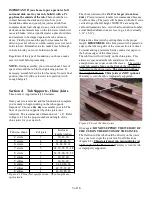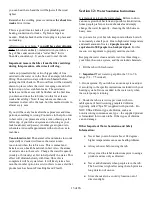
Figure 8.1 Hitting staves directly on the band.
Double-check the vertical placement of the bands now
before things get too tight. It is easier to move the bands
now. Use a tape measure to readjust the bands so they are
placed as shown in Figure 7-2 and the table of band
heights. Step back and make sure that the bands look
level. Adjust as needed.
Now do another round of rapping with the mallet while
tightening the bottom bolt. Use the mirror continuously
to monitor any gaps as you go. This time, hit each stave a
little harder - a good full swing on each one as your
helper tightens the bolts. Alternate tightening each band
a little bit, so that you can keep some tension on the upper
bands so they stay in position.
Figure 8.2 Using a wrench or pliers to hold the blocks
straight as you tighten the bolt.
Turn your attention to the tops of the staves. They should
be lined up nicely giving a smooth interior. If any need
alignment, use the mallet to hit them inward or outward to
bring them into adjustment. Just light taps. You’ll likely
hear them pop into place. Do another revolution of hitting
each stave a little harder now as the bottom band is
tightened. Don’t be afraid to hit pretty hard. Continue
tightening with a wrench. At this point using the mirror,
any gaps should be virtually gone. If not, stop, back up a
few steps – loosen the bands a bit and distribute the gap
as described earlier.
Now do a final tightening - but don’t overdo it. The
bottom band is pressing against the floor on the inside, so
it will reach a point where you can tell it is very tight -
don’t force it beyond that. Use a wrench or pliers to
prevent the aluminum block that the bolt passes through
from twisting as you do the final tightening.
Stop when
further tightening becomes significantly more difficult and
you see noticeable deflection of the aluminum blocks.
This indicates the bottom band is tight enough. As you
tighten the upper bands check the staves from the top end
and make sure their bead to cove interfaces are all well
aligned. Lightly bumping it with your hand can release
tension if they aren’t. The upper bands don’t need to be
quite as tight as the bottom, but still quite snug. If they
feel tight, they are. Do a final adjustment on the top of the
staves at this time. Remember - the wood will swell to
tighten all joints further once water is introduced.
TIP: If you have a torque wrench – the bottom band
should be tightened to about 40 foot lbs. of torque
(similar to a lug nut on a vehicle), the next band up
should be at about 30 foot lbs. the upper ones to a lesser
amount - about 25 foot lbs. of torque. However sometimes
the bolt is too long for even a deep socket. Don’t sweat it.
A torque wrench is optional. Use the preceding
explanations to understand how tight to make things.
Next climb inside the tub and remove the temporary floor
braces.
Your tub is now ready for installation of the heating
system and any other accessories.
Section 9: System Components &
Accessories
Install any accessories
in this order
:
1. Spa Control System - see separate instructions for
your type of system.
2. Benches - see below
3. Topside Controller Mount
4. Tub Access Steps - see below
5. Tub Cover - see below
Benches:
The bench system is simple. These instructions are
specifically for circular tubs.
NOTE: The elliptical tub benches fit at the end(s), and the
larger ellipse tubs (6 or 7 foot) have one or two additional
side benches, respectively.
Each bench is one section of the circle. See the table
below for the arrangement of benches for your size tub.
10 of 16
















